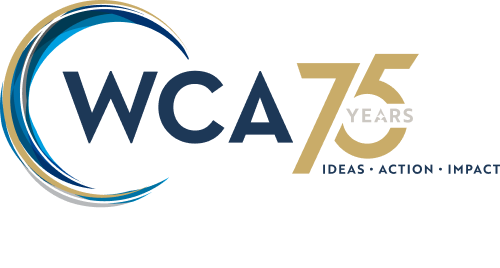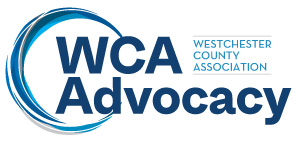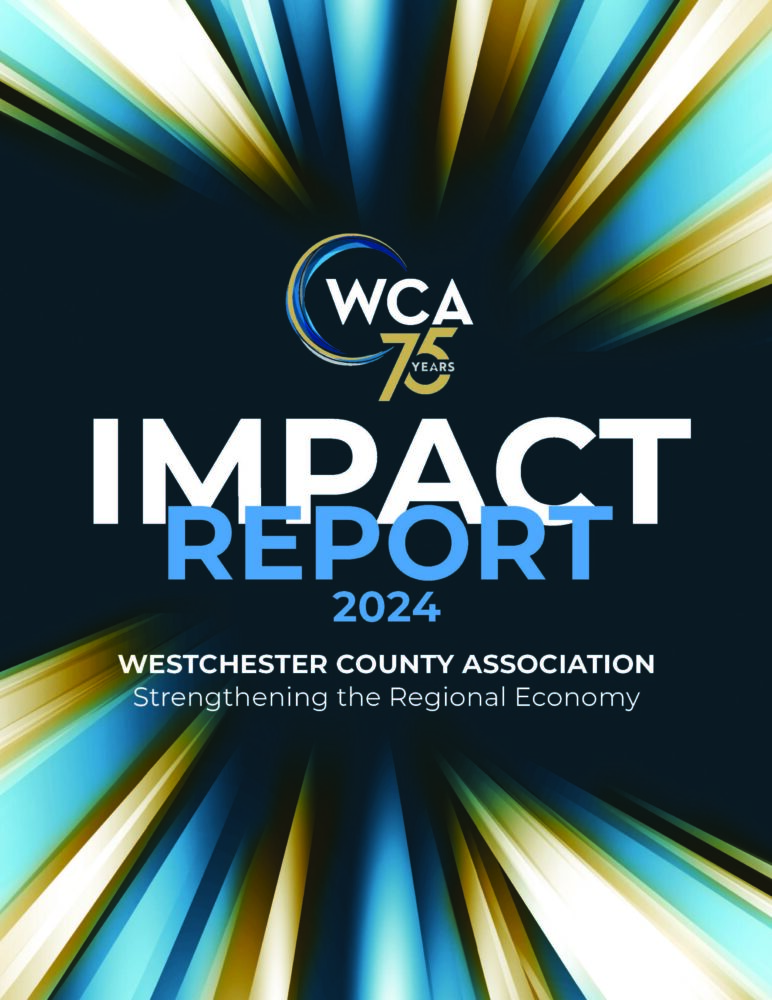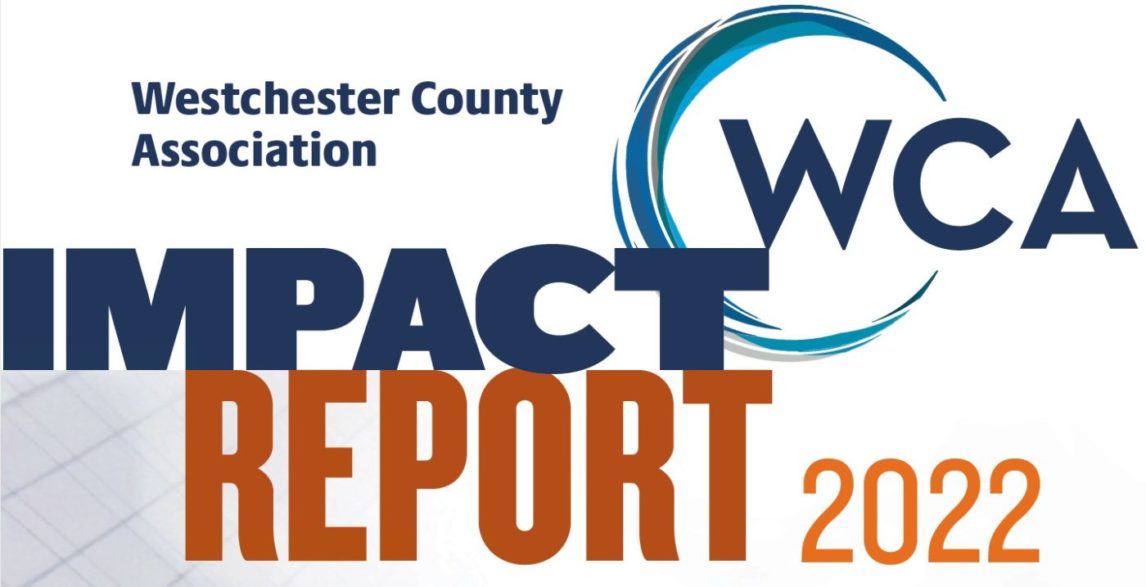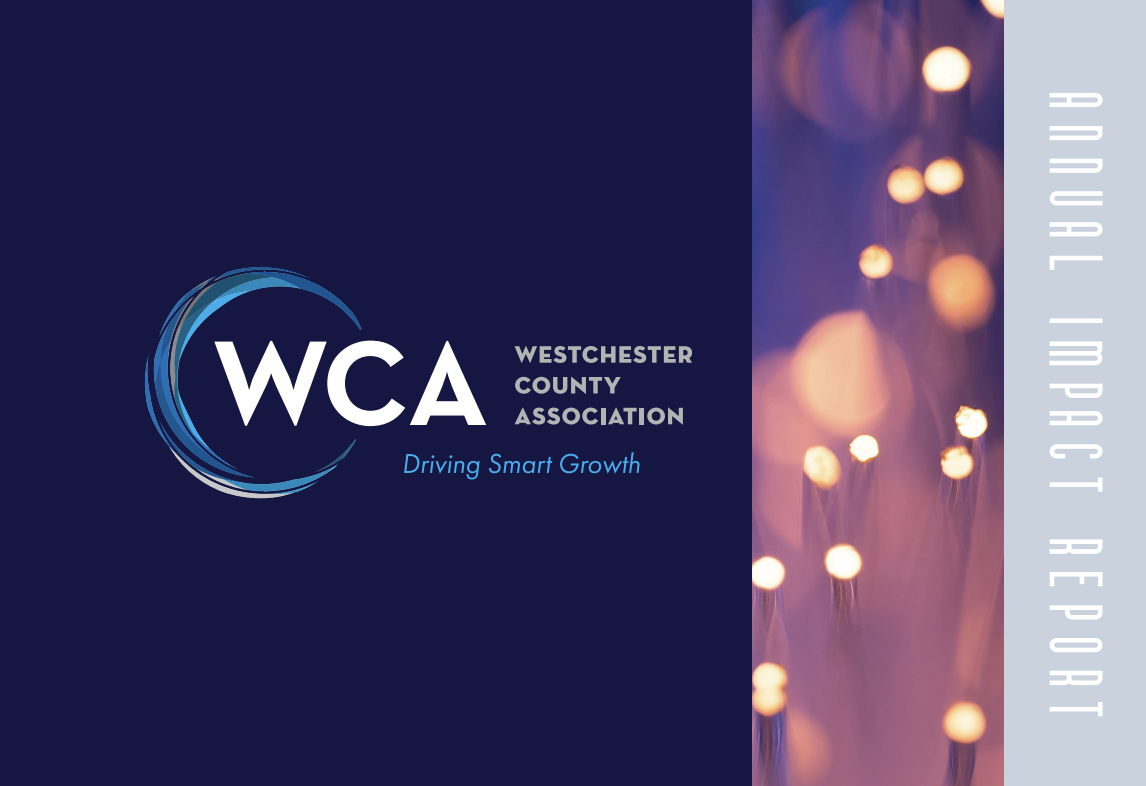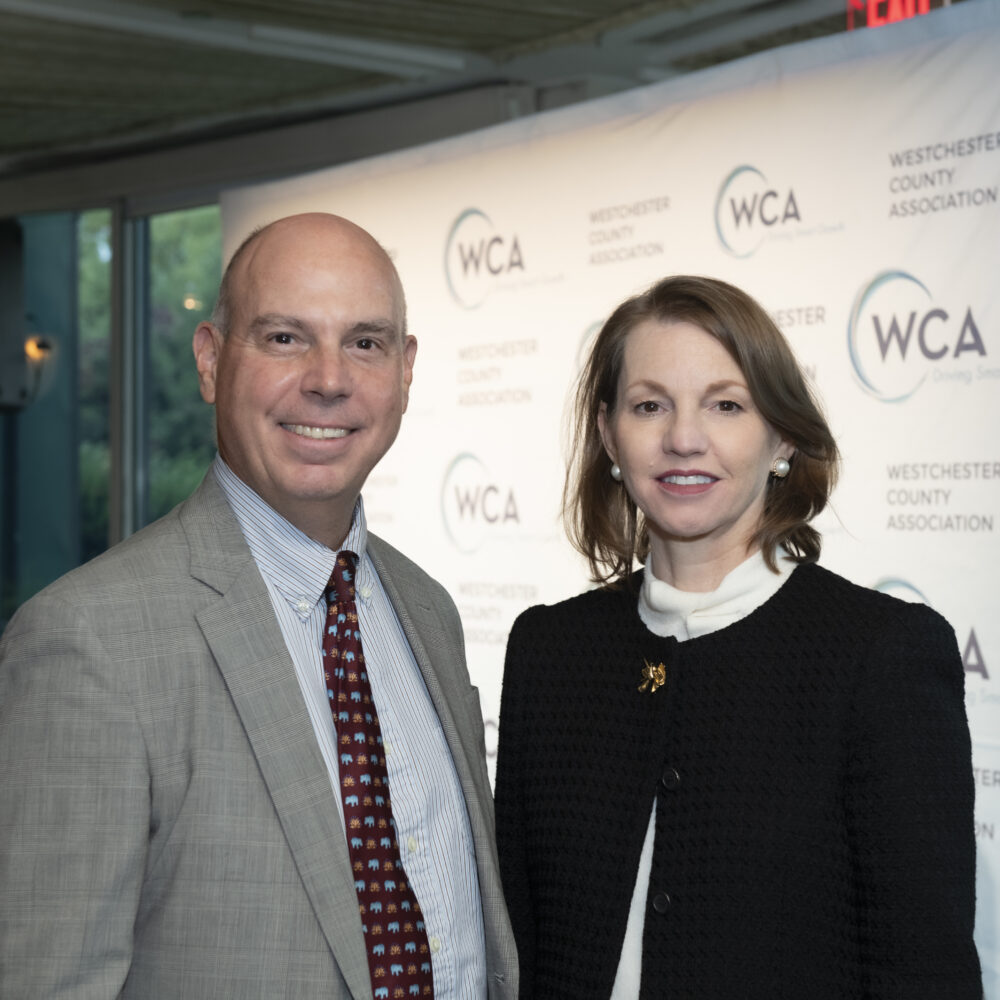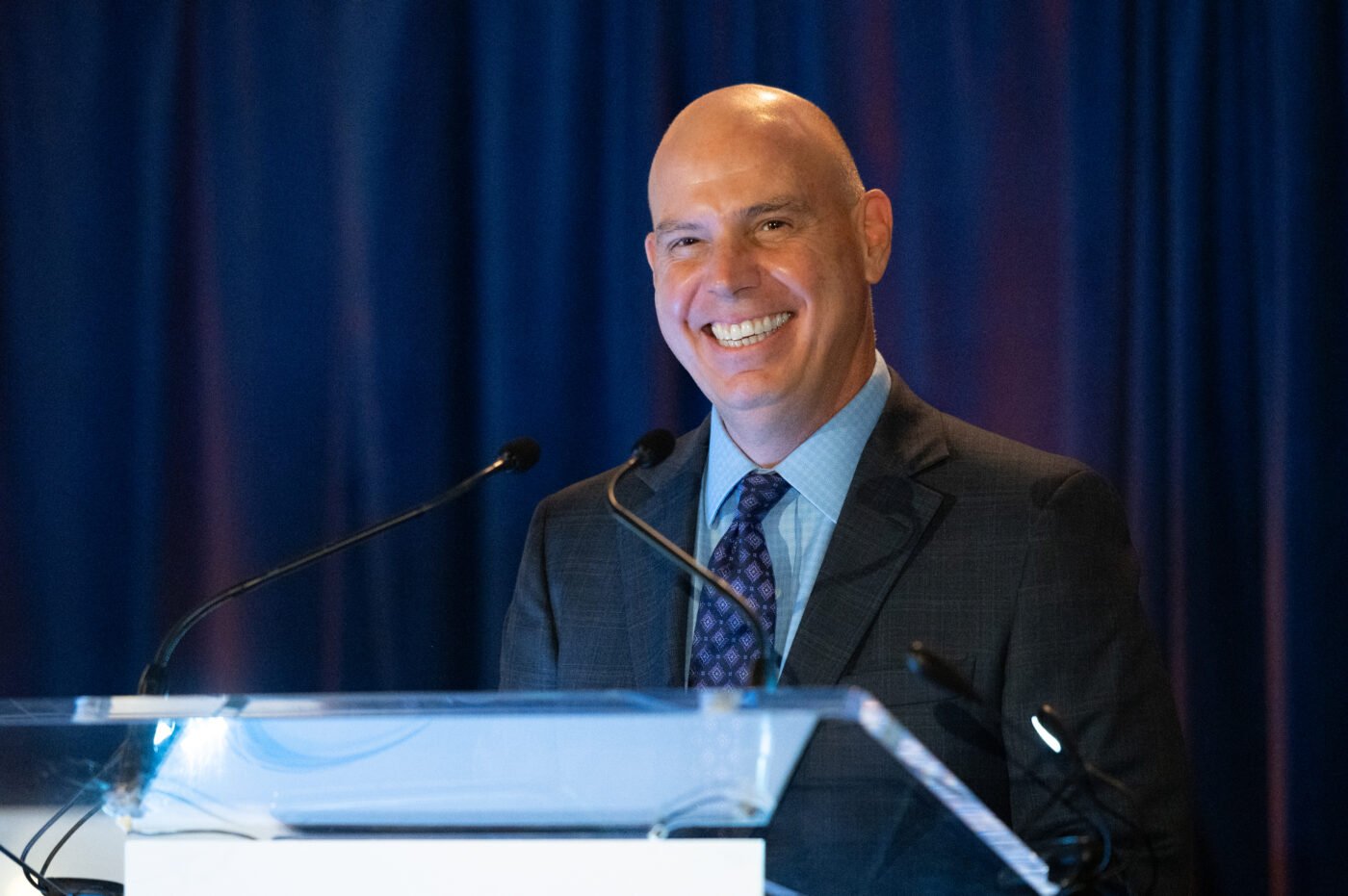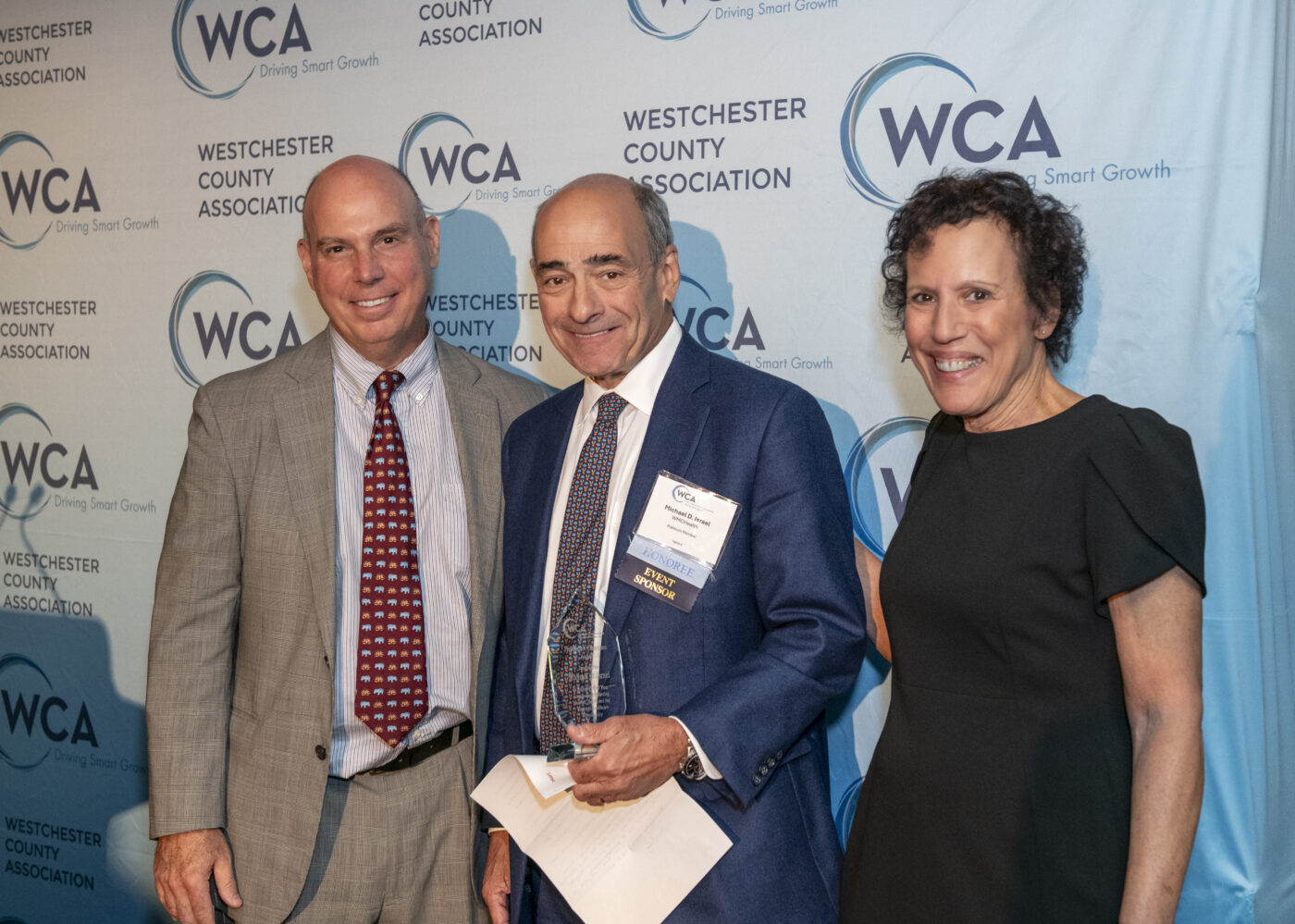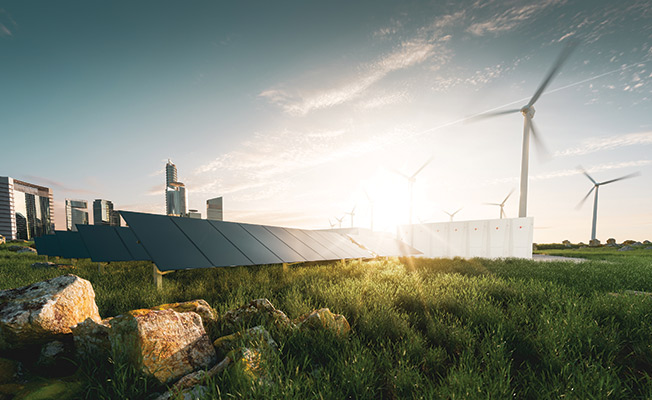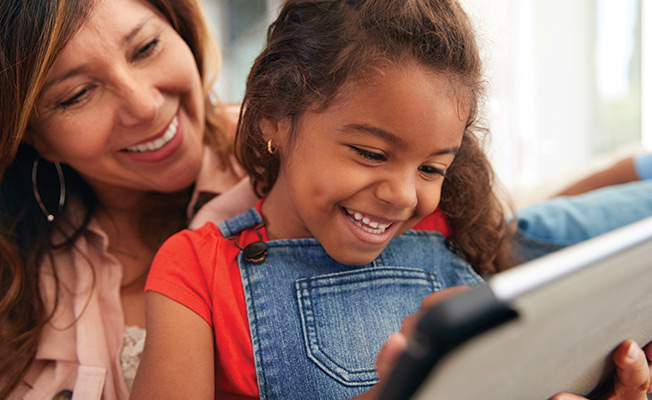NEW YORK ADVOCACY AGENDA 2025
The Westchester County Association (WCA) is the county’s professional roundtable. We unite and mobilize business leaders to advance issues and lead initiatives that strengthen our regional economy. Through collaboration, we drive economic vitality, stimulate new business and job creation, and provide our members with the resources and talent they need to grow.
Our members include hundreds of the mid-Hudson region’s foremost organizations in industries as diverse as healthcare, real estate, finance, law, energy, technology, hospitality, higher education, and the nonprofit sector. They collectively employ hundreds of thousands of workers. For 75 years, the WCA has served as the leading independent voice of the professional community.
While the WCA conducts general business advocacy (responsible budgeting, minimizing tax burden, a light-touch regulatory environment) we, as set forth herein, more specifically address certain top-level priorities consistent with our primary focus areas. This agenda likely will be revised during the legislative session as individual priorities are introduced and advanced.
For additional information about our advocacy initiatives and policy positions on specific items of interest please contact:
Michael N. Romita Amy Allen
President & CEO Vice President
Westchester County Association Westchester County Association
mnromita@westchester.org aallen@westchester.org
O: (914) 948-3671 O: (914) 948-1168
C: (914) 906-7821 C: (914) 943-7433
HEALTHCARE
The WCA’s membership includes hundreds of the region’s foremost organizations representing a broad range of industries including healthcare, real estate, finance, law, energy, technology, hospitality, and higher education. One of the WCA’s primary focus areas is support for a strong and vibrant healthcare system. Our board members include the heads of most major hospital and healthcare providers in the region. We regularly advocate on their behalf, and to expand access to high quality healthcare for our residents and workers.
Healthcare is the largest single economic engine in Westchester County and the surrounding region. Within the lower Hudson Valley, our hospitals alone contribute close to $13 billion in annual economic impact and employ over 54,000 workers. The benefits to the community are both quantitative and qualitative. World class healthcare facilities continuing to expand north of New York City is one of the primary reasons businesses, workers, and residents are attracted to the region.
Fully Fund Medicaid and Disperse Approved Funds in Timely Fashion
The State’s FY 2025 Budget included a $525 million increase in Medicaid funding and yet, as 2024 draws to a close, this funding has yet to be dispersed. It is imperative that the approved funding be put to work and that every hospital receive its fair share of the funding.
In addition, the FY 2025 Budget includes $650 million in capital funding for IT and cybersecurity, amongst other needs. This funding must be disseminated to allow providers to make the infrastructure investments required to comply with the recently released State cybersecurity regulations. Another $250 million is included in healthcare transformation grants which has also not yet been disseminated. Funding provided in the State budget should be dispersed in a timely fashion. In addition, current funding previously budgeted should not be rolled over into the FY 2026 budget.
Notwithstanding a change in national leadership, New York must obtain federal approval for a managed care organization (MCO) tax that was included in the State’s FY 2025 budget. This tax is expected to generate several billion dollars in new federal matching funds and bolster investment in the State’s Medicaid program.
Medicaid reimburses healthcare providers approximately $.73 on the dollar, which is not sustainable especially as the Medicaid population continues to grow. Although federal funding helped to offset many costs of care due to the pandemic, it did not offset inflationary increases in everything from supplies to wages. While the use of traveling nurses has abated somewhat, many recent collective bargaining agreements have met union demands for elevated wage and benefit costs well above inflation. Heightened staffing requirements add to the challenge. Increasing the Medicaid reimbursement rate, especially to ensure the ability of facilities and providers to attract a quality workforce, is critical to ensuring the sustainability of our health care infrastructure.
Address the Healthcare Workforce Shortage
Healthcare workforce shortages continue to grow in virtually every county in New York State. Shortages preexisting the pandemic are now magnified by recently enacted staffing ratio laws for nursing homes and hospitals. The State has made some movement towards alleviating those shortages, including 2023 passage of clinical simulation legislation which allows for up to 30 percent of clinical hours to be earned via simulation training.
However unrealistic staffing ratio requirements for nursing homes and hospitals cannot be met. The hospitals have complied with recent legislation requiring the establishment of an advisory staffing committee. The WCA resists additional efforts to increase healthcare staffing ratio requirements or levy fines due to unrealistic staffing goals.
- Targeted Nurse Educator Funding — The nursing shortage in New York is already at a crisis level with record numbers of nurses retiring, retiring early, switching jobs or quitting. According to the NYS Department of Health, an additional 40,000 nurses are needed by 2030. This crisis is further exacerbated by the severe shortage of nursing faculty, with U.S. nursing schools having turned away over 90,000 qualified applications in 2021 alone. A recent survey showed 2,166 full-time faculty vacancies at 909 nursing schools in the U.S.
Accordingly, the WCA calls for funding a regional pilot through a Nurse Faculty Recruitment and Training Project to help our regional nursing schools educate the nurses needed by our hospitals and healthcare providers.
Make Scope of Practice Flexibility Permanent
During the pandemic, numerous temporary measures were enacted through executive orders that provided scope of practice flexibility among the various health care professions. The pandemic proved the value of those provisions. They remain an invaluable tool in ensuring access to services otherwise unavailable due to staffing shortages.
To ease workforce issues, every clinician should be allowed to use the fullest extent of their training. More specifically, permit individuals who meet federal requirements for performing high complexity testing to perform such testing.
Enact Medical and Nurse Licensure Compact Legislation
Enacting the Medical and Nurse Licensure Compact was included in Governor Hochul’s 2024 State of the State address but was not supported by the legislature. This legislation would strengthen access to health care by providing a streamlined process for NY clinicians to become licensed in multiple states. Currently 39 states are part of these compacts.
We support the passage of the several bills that have been introduced to enact this legislation: 2023_A3391 (O’Donnell); S2216/A4880 (O’Mara/Palmesano); A9301 (Paulin); S6873/A7496 (Ortt/Miller).
Rein In For-Profit Health Insurers
For profit health plans wield enormous market power over the state’s healthcare system. Collectively, the largest for-profit health insurers drive record profits while hospitals continue to struggle, typically with 1 percent profit margins or worse. Hospital margins are eroding while insurance profits continue to climb.
- Address Payment Delay and Unfair Denial of Claims – Healthcare providers and patients alike are routinely denied or delayed care deemed medically necessary and included as part of a contractual insurance plan. Insurers have intentionally made it part of their profit model to deny and delay payment for claims. By some estimates, an average of $4.9 million per hospital has been put at risk due to denials. Enacting legislation to address these issues would mitigate the cash flow impact to hospitals for withheld payments and ensure that patients receive the treatment they need without delay. Any health plan would still be able to challenge any procedure it believes not medically necessary but would no longer be able to lever its unfair financial advantage by holding hostage caregivers and patients. Recent legislative solutions supported by the WCA include:
- Prior Authorization Reform – A. 7268 (Weprin) / S.3400 (Breslin)- addresses bureaucratic obstacles that unreasonably impact patient care.
- Approval of Claims if Insurers Fail to Issue Timely Response — A.6898 (Weprin) / S.3402 (Breslin)- Health Plans are incentivized by current law to delay or ignore requests for care. This legislation would ensure better enforcement of the statutory timeframes for insurers to issue determinations.
- Address Down-Coding Abuses – A.6937 (Weprin)- The legislation would also prohibit plans from reversing medical necessity determinations made by a utilization review or external appeals agent.
- Enact a Healthcare Reinvestment Act — The large national health insurers are often domiciled outside of New York and their significant profits are funneled back to their corporate headquarters and to shareholders. The banking industry is encouraged by law to invest in communities in which they do business through the Community Reinvestment Act. For-profit health insurers should do likewise where they derive significant profit. The reinvestment should be earmarked for technology and capital upgrades, workforce training programs and other community-based health initiatives.
Oppose Detrimental Legislation
- The WCA opposes the Grieving Families Bill — S6636/A.6698 (Hoylman-Sigal/Weinstein) following its third consecutive veto. In its current form, this legislation would vastly inflate medical malpractice premiums (45% or higher by some estimates) by expanding the kinds of damages recoverable in a wrongful death as well as the pool of potential claimants. Healthcare providers in the Hudson Valley already pay some of the highest malpractice premiums in the region. Premium increases caused by this legislation will drive healthcare providers from New York to competing markets and limit access to care. The Governor has vetoed this bill for the past two years and the WCA will continue to oppose this legislation if re-introduced in its current form.
- The WCA opposes the Local Input in Community Healthcare (LICH) Act (A01633B (Simon)/ S08843-A (Rivera), which makes the regulatory process for discontinuing healthcare services and facilities more expansive and burdensome and is duplicative of measures already in place. The LICH Act would create an extensive, nine-month long process for the closure of hospitals and nearly as burdensome a process for the much more routine changes in service lines that hospitals must make to respond to patient demand, competition in the market and clinical staffing. The legislation will further distress hospitals already facing difficult decisions in a financial crisis and hamper routine business decisions. This bill was vetoed in 2024 and the WCA will continue to oppose similar legislation of re-introduced during the 2025 session.
- The WCA opposes Senate Bill S9952 to enact “site neutral” payment policy for certain healthcare services in New York State. This legislation unfairly penalizes hospitals’ ability to cover their costs at hospital owned outpatient facilities.
REAL ESTATE AND HOUSING
The Westchester County Association remains focused on statewide solutions to address local zoning and land use barriers to building the housing we need. Despite the need to address our housing shortage rising to the top of the State’s legislative agenda over the past several years, no meaningful reform has yet materialized.
Housing development is both good for the local economy and good for the community. It creates jobs and decreases the tax burden for essential services without overly encumbering school systems or stretching the delivery of those services. It integrates people of diverse backgrounds and fosters a sense of shared belonging. A housing shortage this dramatic is bad for Westchester’s future. It impacts our ability to remain competitive in attracting new employers who will create new jobs, the ability of existing employers to hire high-quality workers, and the ability for local municipalities and school districts to stabilize the growth of already-high property taxes.
The economic, social, and environmental costs of inadequate housing transcend local boundaries and affect the entire region. Although we share this issue with other states in the region, New York stands alone in its inability to marshal statewide solutions. According to research by the Brookings Institute, NYU’s Furman Center and others, as compared to its peer states, only New York lacks the statutory tools to promote land-use reform and housing production in its suburban communities. While there has been some recent progress, decades of experience with a piecemeal, jurisdictional approach to the housing crisis has failed to yield the necessary results and we need a statewide fix.
SUPPORT STATEWIDE HOUSING REFORM
Create a Reasonable and Predictive SEQRA Process for High-Value Housing Projects
The State Environmental Quality Review Act (SEQRA) is creating costly and unjustifiable delays in the development of new housing. The law’s noble underpinnings are designed to protect the environment by avoiding hasty decision-making. But SEQRA has become weaponized by overuse and has morphed into a procedural quicksand of delay. Reform it by creating fast-track consideration for certain classes of development – e.g., housing with a certain level of affordability, housing with certain policy benefits like passive house construction or other climate mitigation features, or housing in a particular valuable zone for redevelopment as part of a Downtown Revitalization Initiative grant. Environmental review is the most time-consuming and costly phase of the land use decision-making process. It is also unpredictable and unevenly applied across local jurisdictions.
The WCA supports a streamlined local zoning and land use approval process subject to strict deadlines for qualifying housing developments. Local land use decisions should remain with local governments.
However, the state retains the power to set the terms and standards for local review and it should exercise that power to advance statewide goals. Some specific suggestions for SEQRA application:
- Create a streamlined process for projects which meet clear and objective planning standards. Establish a tiered but finite timeline for the municipal application review process depending on whether the review is short-form or long-form and the size of the development. Extensions can be accommodated presuming they are supported by reasonable circumstances with a specific and clear path for process conclusion.
- Reduce the number of topics to review outside of those with direct environmental impacts.
- Increase size threshold triggering environmental review.
- Exemptions for projects with clear environmental impacts and unlikely to have adverse impacts.
- Support an appeals process for zoning changes rejected by local governments.
- Support “vested rights” reform to prevent zoning changes from negatively impacting developments in process.
Prior bills that partially take this approach:
A.4933A (Kelles) / S.925A (May) — provides that housing and infill projects where the applicants have been certified by an expert that they do not violate state environmental laws, meet an affordability threshold, and where the application receives certification for sustainable construction techniques, should either have a limited SEQRA review or be deemed exempt from SEQRA.
A.3111 (Kelles) / S.0668 (May) provides that qualifying projects with a substantial percentage of low- and moderate-income housing shall receive an up-or-down decision within 40 days of the end of a public hearing on the project and enumerates a concrete list of factors that would justify a no vote.
In addition to this draft legislation, the Governor’s office has recommended streamlining process at the N.Y. State Department of Environmental Conservation. The WCA supports these efforts as they relate to increasing the housing supply.
Pursue Transit Oriented Development Which Maintains Local Decision-Making Authority
While recent transit-oriented development (“TOD”) proposals created a firestorm, the concept does need to be pursued as one of the most high-value ways of increasing housing stock. Increasing housing capacity near public transit hubs and commercial corridors is low-hanging fruit. However, there are approaches that would yield better results and less opposition to the blunt circle-drawing as-of-right zones envisioned within the failed Housing Compact. Local authorities can retain discretion to establish their own solutions so long as they commit to take action.
Examples Include:
Massachusetts Transit-Oriented Development law (Sec. 3A of MGL 40A) requires the 170 MBTA communities to submit a plan for an as-of-right TOD density zone within half a mile of transit stations but allows the local community to pick the zone so long as it is “of reasonable size” rather than hold the entire radius of land to a prescribed density. Local governments retain the authority to undertake their own zoning decisions.
New Jersey’s Transit Village Initiative represents another approach. This incentive-only, multi-agency Smart Growth partnership creates incentives for municipalities who meet certain Transit Village Criteria and complete a Transit Village Application. Those so designated receive technical assistance and priority consideration for grant funding by the state agencies that make up the Transit Village Task Force.
Require Communities to Create a Local Housing Action Plan
The oft-expressed virtue of local control is that those closest to the community have the best sense of local needs and can plan accordingly. Unfortunately, only a handful of Westchester communities have wrestled with the housing needs in their community and the region with thoughtful planning. Many have comprehensive plans that are decades out of date or barely mention housing. Generic Environmental Impact Studies are rare. Most housing applications are still considered as one-offs rather than as part of a local plan to address the severe needs for housing while also factoring in infrastructure concerns, available lands, the redevelopment of underutilized buildings, and the specific needs of that community in terms of income levels, housing costs, and at-risk communities. Similarly, each community need not use the same tools and strategies.
As with the 2020 executive order requiring each local government in New York State to adopt a policing reform plan, each community should be required to produce a local housing plan reflecting the needs of the community and local factors established through a preponderance of evidence, rather than the particular concerns of a small number of individuals at a single public hearing.
Prior bills that partially take this approach:
A.2017 (Thiele) requires local governments to prepare and adopt an affordable housing plan with public input and update it every five years. Unfortunately, the current version of the bill includes a “character of community,” element which is both vague and also has an unfortunate history of misuse
Strongly Incentivize Comprehensive Plans Which Contain a Robust Housing Element
Ideally, a local housing plan would be accompanied by a comprehensive plan for a holistic look at the community. This is a large endeavor, however, and many municipalities lack funding, bandwidth, or expertise to run the whole process. The state should take a leading role with incentives so that more municipalities can employ any of the following options:
- Funding for adopting comprehensive plan component that furthers one or more housing types that meet local market, social, and environmental needs.
- Amended SEQRA rule declaring these housing types receive presumptively negative declarations.
- Create a class of sustainable development projects that are eligible for administrative review and approval and waiver of land use regulations.
- Provide infrastructure funding to support sustainable development projects.
- Enhance set asides of LIHTC and other affordable housing funding.
- Incentivize housing development through increased eligibility for real property tax abatement, more AIM funding, school funding, and bonus consideration for other relevant state funds.
Utilize Infrastructure and Other Funding to Incentivize Housing
Sufficient funding for infrastructure improvement grants tied to measurable progress in addressing the statewide housing shortage is a fundamental building block for progress, and a must in next year’s state budget. We also recommend additional financial support for municipalities who can demonstrate that they are addressing housing, including:
- Grants for the process to update a municipality’s comprehensive plans.
- Incentive funding to cover the costs of a Generic Environmental Impact Statement (GEIS) for communities that have created a housing growth overlay zone or other rezoning to support increased multifamily.
- Adding an annual bonus to Aid in Municipality (AIM) funding tied specifically to achieving pro-housing actions or bringing new housing online.
- Creating additional points or AIM bonuses for achieving key pro-housing milestones, like completing a comprehensive plan update, or achieving a threshold of new units open for sale/rental in a calendar year, with increased weight for affordable units.
Strengthen the Pro-Housing Communities Program
The State’s Pro-Housing Communities Program limits eligibility for certain discretionary funding grants to local governments that take action to support housing growth. Eligible grant programs include numerous programs which apply directly to Westchester and the Mid-Huson region such as the Downtown Revitalization Initiative, the Mid-Hudson Momentum Fund, and the NY Main Street Fund.
The WCA advocates for expanding the Pro-Housing Communities Program to act as an umbrella certification for a broader array of funding, especially programs designed to address infrastructure capacity issues and technical support needs. In addition, the funding streams should allow for additional flexibility to permit an array of uses related to housing supply. The WCA further advocates for an enforcement mechanism to ensure that discretionary funds under the Program actually lead to new housing supply.
Create An Enforcement Mechanism
The WCA supports legislation establishing a state-level appeals procedure with the authority to review decisions on qualified low-or-moderate income housing applications when found to be unreasonable and not consistent with local needs. Local decision-making should be retained but must be held accountable when not supported by objective standards and empirical facts.
An effective set of solutions will include both carrots and sticks. Housing incentives are necessary and valuable. Many of our towns and villages need financial and technical assistance. In addition, for the sake of equity among municipalities and to combat historical patterns of housing exclusion and even housing discrimination, some enforcement mechanism should be available.
Examples include:
A.3111 (Kelles) / S.0668 (May) — Creates a state zoning board of appeals to consider applications for low or moderate-income housing development that may have been wrongly rejected at the local level.
The New Jersey Mt. Laurel Doctrine — Sets a “Fair Share” percentage goal of housing that must be affordable in each town, and allows for enforcement if towns fail to comply with their fair share obligations, including builder’s remedy lawsuits and other compliance challenges in court. It does not privilege one type of meeting the housing goal over another but does allow for judicial enforcement if a town falls short.
Chapter 40B in Massachusetts (a.k.a. “the Builder’s Remedy”) – Sets a fixed percentage of housing units that must be affordable for each municipality. If the municipality is under that goal, and if it has rejected an application for housing, the applicant can appeal that decision to a State Zoning Board of Appeals. If it is empirically determined that the municipality is under its goal, the rejection can be overruled. This policy has been in place since the 1960s.
Connecticut CGS 8-30g – Creates a housing appeals procedure similar to Massachusetts 40B and places a reasonableness burden on local boards that deny proposals for affordable housing developments. TTL8$$30GU (ct.gov).
SUPPORT THE WELCOME HOME WESTCHESTER “5 IN 25” LOCAL HOUSING AGENDA
In addition to focusing closely on state-level solutions, the WCA also steers the County’s Welcome Home Westchester campaign and its “5 in 25” agenda. This agenda is tailored towards local municipalities and sets forth five voluntary steps that every village, town, and city in Westchester can take to help address the housing crisis as follows:
- Produce a Housing Action Plan that is specific to local needs and considers unique conditions and characteristics;
- Create Fast Track Environmental Review for sustainable, energy efficient housing and transit oriented development;
- Promote Accessory Dwelling Units and Transit Oriented Development by passing ordinances encouraging such developments;
- Establish a “Core Training Curriculum” for volunteer land use board members to help them understand the housing crisis and how their decisions can impact the issue; and
- Become a Pro-Housing Community pursuant to the State’s Pro-Housing Communities Program.
ENERGY AND SUSTAINABILITY
With passage of the Climate Leadership and Community Protection Act of 2019 (“Climate Act”), New York has embarked on an ambitious state-level effort to address climate change. As required by the Climate Act, the state’s Climate Action Council has produced scoping plan providing a road map on how to meet the Climate Act’s greenhouse gas emissions reduction targets.
However, by some accounts, New York is advancing a law without a fulsome understanding of its economic impact. The Climate Act will alter the state economy without related appropriations or a plan for how to finance the transition. Moreover, the upfront costs will be largely internal while the climate benefits are diffuse. Those costs should not fall presumptively to the private sector. Rather, they should be spread widely and with state and federal assistance.
Notwithstanding these obvious challenges, the WCA continues to support the Climate Act’s underlying premise and its ultimate goal to transition to a carbon-free economy by 2050. The WCA advocates for increased state and federal funding programs for buildings and businesses forced to adapt. The WCA further advocates for streamlining and accelerating efforts to build both large scale clean energy supply and transmission systems as well as more localized, behind the meter projects.
Provide State and Federal Funding Mechanisms to Accelerate Building Electrification
The WCA opposes an accelerated fossil fuel phase out for existing buildings absent major funding mechanisms and technical assistance programs tied to the increased costs of construction or conversion. The Climate Action Council’s Scoping Plan concludes that, at 32 percent, buildings are the single largest contributor to statewide emissions. Recent passage of the All-Electric Buildings Act requires most newly constructed buildings in New York to be built with electric heat and appliances beginning in 2026 for smaller buildings and 2029 for larger buildings. Certain exemptions applied for hospitals, medical facilities, factories and industrial facilities. Due to pre-existing natural gas service constraints, most new buildings throughout Westchester are already being built electric.
Particularly with respect to energy reliability concerns, the pace of decarbonization will depend as much on the speed at which the built environment can physically transition from fossil fuels as on the timeline for developing new sources of supply.
Project developers agree that net-zero building conversion will be very expensive. Our information indicates that converting a typical commercial office building to electric would cost upwards of $45 per GSF even before factoring in contractor mark-ups and contingencies. There are cost differences due to vintage, size, height, and rigging. Even so, with this simplified calculation, retrofitting many buildings in Westchester would not be supported by any reasonable payback period on its lifecycle. Extrapolating this data to the residential market, the damage would be particularly severe for cooperatives, condominiums, and other buildings which house working class families.
Technical and financial concerns surrounding Local Law 97 in New York City would be magnified in Westchester where compliance costs would be similar, but asset values are significantly less. Cost concerns are heightened in a challenging market for commercial real estate.
Accelerate Large Scale Renewable Energy Projects
The WCA strongly supports continuing statewide efforts to streamline large-scale renewable energy infrastructure projects (production and transportation) through the Public Service Commission and the Office of Renewable Energy Siting. Moreover, the state must be flexible in managing its contractual arrangements with large scale developers where macro-economic issues, such as inflation or supply chain demands, challenge project viability. Public private partnerships such as those advanced by Westchester-based New York Power Authority are critical to advancing our energy goals, cutting emissions of carbon and other criteria pollutants, and spurring job creation.
The State must accelerate passage of new regulations for siting large-scale renewable energy projects through the Office of Renewable Energy Siting as required by the Accelerated Renewable Energy Growth and Community Benefits Act.
In addition, the State should extend credits and other incentives for distributed generation through the NY-Sun program, with a focus on the mid-Hudson and downstate markets.
Support for “Cap and Invest”
The WCA supports a trading mechanism which will improve the efficiency of any cap and invest program, which is sensitive to the concerns of disadvantaged communities, and which mitigates increased costs to low- and moderate-income households. The WCA is strongly supportive of a cap and invest approach for reaching the goals of 2019’s CLCPA. However, as the Department of Environmental Conservation and NYSERDA rulemaking play out pursuant to 6 NYSRR Part 252 a multitude of questions remain concerning, inter alia, emissions accounting, reporting requirements, allowance mechanisms, compliance, and (importantly) the availability of trading.
Fix the CLCPA’s Accounting Methodology
The WCA supports efforts to align the State’s GHG emissions accounting system with federal standards consistent with the Intergovernmental Panel on Climate Change.
The accounting methodology employed by the CLCPA for measuring greenhouse gas emissions reductions is an outlier amongst other states which have undertaken similar measures and also within the international community. Without a legislative fix, it will hurt New York businesses and consumers by placing the State at a competitive disadvantage. In addition, inconsistencies with other similar programs will severely complicate a regional approach to meeting New York’s emissions reduction goals and will hinder available federal funding from reaching the State. Recent legislation advancing this goal includes S6030/A6039.
Local Land Use Restrictions Which Hinder Clean Energy Siting Must Be Overcome
As with housing, local land use and zoning restrictions often impede the development of small-scale renewables and smart building technologies. The Climate Action Council’s Scoping Plan identifies the need to address local land use restrictions and clean energy siting as one of its goals primarily through public outreach and education. Recent experience in the housing context foreshadows the need for a cohesive statewide approach and a stronger, more proactive legislative hand. This will take a combination of mandates and incentives. Local moratoria and blanket renewable energy bans should be rejected.
Moreover, just as with the dedicated ORES to streamline and expedite the siting of renewable energy supply, New York will require SEQRA workarounds and statewide zoning requirements to create more environmentally favorable projects such as transit-oriented development (“TOD”), multi-family development, and utility scale solar, wind, battery storage and geothermal projects.
Another model that New York State should consider following is the federal Telecommunications Act of 1996 (the “TCA”), which does not preempt local zoning authority. Rather, it prohibits discrimination among wireless providers and prevents a municipality from completely banning wireless facilities within its borders. A similar New York State statute would require municipalities to accommodate appropriately sited alternative energy facilities and provide for expedited appeals of denials which are based on community opposition as opposed to substantial evidence in the written record.
Put the Environmental Bond Act to Use
The state must deploy expeditiously last year’s $4.2 billion Clean Water, Clean Air and Green Jobs Environmental Bond Act. Maximize opportunities for project funding through recent federal funding streams from the Inflation Reduction Act and the Infrastructure Investment and Jobs Act. Specific priorities most impactful for Westchester and the mid-Hudson region include: (a) water quality improvement, resiliency, and flood risk reduction; and (b) support for green infrastructure and carbon emissions reduction in the built environment.
Ensure Adequate Funding for Public Transportation
A robust and well-functioning mass transit system linking New York City to the suburbs is integral in reducing carbon emissions caused by transportation. The State must continue to invest in the Metropolitan Transit Authority’s capital projects and ensure that dedicated transit funds are not diverted to other uses.
Continue Funding the Climate Smart Communities Program
Program funding for the Climate Smart Communities Program should be continued, and our downstate communities should be strongly encouraged to take full advantage. According to the N.Y. State Climate Action Council’s Scoping Plan, local decisions on the way we use land, where to develop, and how to arrange and design that development constitute critical first steps in addressing climate change. These decisions directly impact the ability to achieve carbon mitigation, sequestration, and adaptation and resilience goals.
The Climate Smart Communities Program encourages local municipalities to implement projects focused on climate change adaptation and greenhouse gas emissions mitigation through competitive grant funding. Although the vast majority of Westchester communities have registered for the program, less than half have taken any further action.
BROADBAND AND DIGITAL CONNECTIVITY
Westchester County’s Office of Economic Development recently released a strategic report concluding that “the digital divide…is a key hurdle in economic development” (Westchester Economic Development Strategy, Recovery & Implementation Plan, Dec 2020). Moreover, a recent NY State comptroller’s report illustrates both that there is an overweighted need for broadband infrastructure and connectivity in the mid-Hudson region and that this region is not seeing our share of state grant funding. See https://www.osc.state.ny.us/reports/availability-access-and-affordability-understanding-broadband-challenges-new-york-state
U.S. Census Bureau data identifies 40,000 households in Westchester County without an internet subscription. Further, these households are strongly concentrated in impoverished and/or minority neighborhoods. This same data shows a gap in device ownership, or reliance on smartphones only, affecting 20,000 households.
The Westchester County Association supports both a light-touch regulatory environment that encourages the rapid deployment of broadband infrastructure as well as robust programs enhancing digital equity. Moreover, the WCA opposes legislation designed to create unnecessary and artificial barriers to business for internet service providers.
Leverage Federal Funding
The federal government is deploying billions of dollars in post-pandemic stimulus funding focused on improving connectivity. The state should maximize funding opportunities by removing policy barriers inhibiting rapid infrastructure deployment needed for fast and reliable internet service to our businesses and residents.
Streamline Regulation and Broadband Construction
The WCA advocates for pro-broadband state legislation including streamlining permitting of fiber and wireless projects and/or municipal implementation of pro-broadband policies. Layers of duplicative regulations add unnecessary expense to infrastructure build-out. The WCA further opposes the dissemination or amplification of scientifically bogus theories concerning the health impacts of mobile infrastructure which would delay the implementation of 5G technology.
Support Legislation Eliminating Certified Survey Requirements for Broadband Infrastructure Builds
The WCA supports legislation to repeal the DOT survey law such as last session’s bill A.9894 / S.8472. In recent years, the State has taken several actions which have caused a significant backlog in the deployment of fiber-optic facilities throughout New York State and, as such, have delayed the availability of broadband services to many New York residents and businesses. In 2019, New York became the first state in the nation to charge fees on fiber cables used for broadband deployment when the fiber is placed on state highway rights-of-way. This fee has since been repealed.
However, in 2020, the DOT added a new requirement to the expanded consolidated permit application for the deployment of fiber used for broadband deployment. Specifically, this new requirement requires an applicant to provide certified engineering surveys for all infrastructure (both the applicant’s infrastructure and third-party infrastructure) located in the State’s own rights-of-way (ROW) — even when the applicant proposes to install or modify facilities on infrastructure that already exists in the rights-of-way. This unnecessary, costly, and burdensome step adds significant expense and time to the deployment process and there is no reasonable or rational need for such a survey in this circumstance. A better solution is to eliminate all requirements for certified surveys as New York seeks to invest billions towards broadband builds across the State to close the digital divide and to catapult New York toward the top of the list of the states that lead the technology curve.
Support For Digital Equity Initiatives
The WCA remains at the forefront of innovative projects designed to connect underserved populations to the digital economy. It’s Y-Zone digital opportunity zone in Yonkers, N.Y. – now expanded into Connect Westchester — brings a direct physical presence to the community for digital navigator assistance to enable households to source free or low-cost internet from existing broadband providers and fund new devices and critical tech education. This creates economic opportunities through workforce training and job development, healthcare access, financial literacy, and connection to on-line resources.
We advocate for the expansion of statewide programs such as the Statewide Digital Equity Plan to support use of the internet. Both the State’s ConnectAll office, and federal dollars received by the State through the National Telecommunications and Information Administration (NTIA) should fund proven programs such as Connect Westchester that enhance access to broadband and not just infrastructure deployment. The State’s digital equity focus must include utilization outcomes as opposed to simply physical buildout.
Support Renewed Funding for the Federal Affordable Connectivity Program
New York must support refunding the ACP through legislation such as this year’s Federal ACP Extension Act. The Affordable Connectivity Program (ACP) was established pursuant to the bipartisan Federal Infrastructure law of 2021 to make high-speed internet access more affordable. Prior to expiration, it assisted over 40,000 households in Westchester County with a $30 monthly discounted internet bill. The ACP’s wind down jeopardizes New York’s taxpayer-funded broadband investment and digital equity plans.
